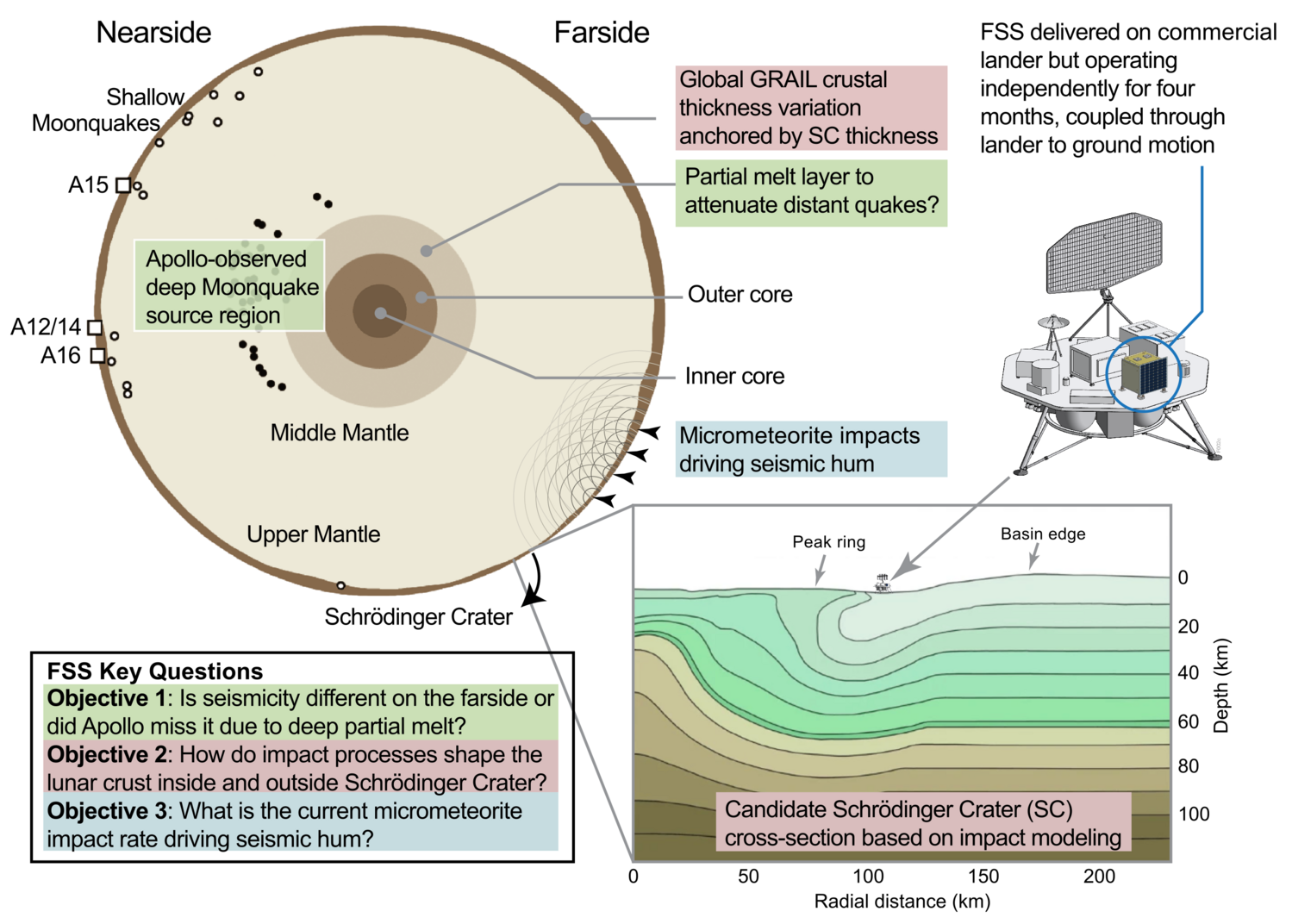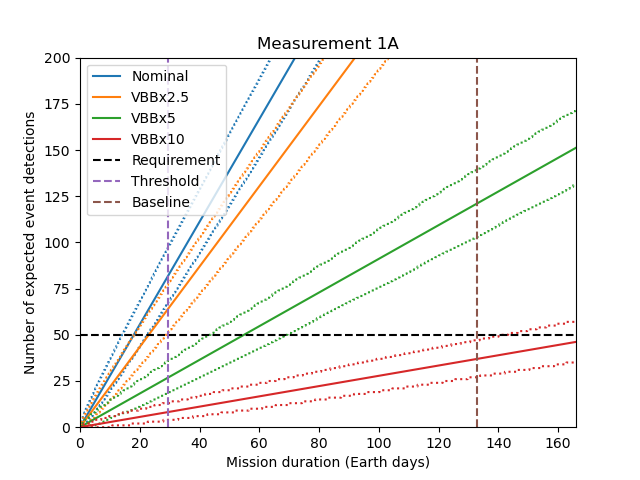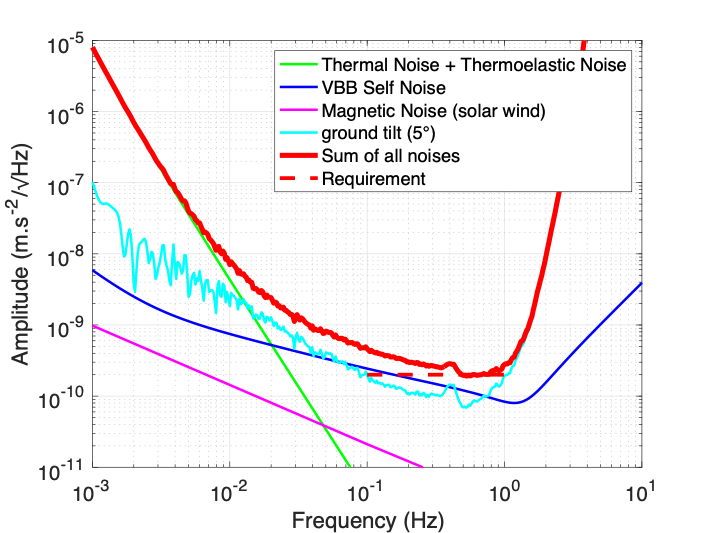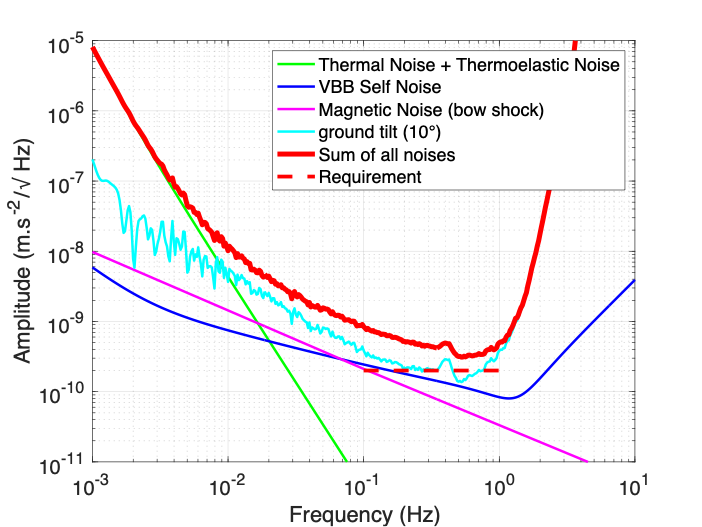- 1Jet Propulsion Laboratory, California Institute of Technology, Pasadena, United States of America (mark.p.panning@jpl.nasa.gov)
- 2University of Oxford, United Kingdom
- 3ISAE-Supaero, Toulouse, France
- 4Institut de Physique du Globe, Paris, France
- 5Imperial College, London, United Kingdom
- 6NASA Marshall Space Flight Center, Huntsville, AL, United States of America
The Farside Seismic Suite (FSS), recently selected for flight as part of the NASA PRISM (Payloads and Research Investigations on the Surface of the Moon) program and planned for flight in 2024 or 2025, would deliver two seismometers (both flight-proven through the InSight mission to Mars [Banerdt et al., 2020]) to Schrödinger Basin. The vertical Very BroadBand (VBB) seismometer is the most sensitive flight-ready seismometer ever built [Lognonné et al., 2019], while the Short Period (SP) sensor is the most sensitive and mature compact triaxial sensor available for space application [Lognonné et al., 2019]. Packaged as a self-sufficient payload, with independent power, communications and thermal control allowing survival and operation over the long lunar night, the FSS will outlive the commercial delivery lander, and provide a long-lived seismic experiment capable of answering key scientific questions (figure 1).
FSS will address three science objectives with this project:
- Investigate deep lunar structure and the difference between near and farside activity. Understanding the absence of farside seismicity recorded on Apollo seismometers [e.g. Nakamura et al., 1981] is fundamental to our understanding of the lunar deep interior. Does it reflect a nearside-farside difference in activity rate, or does seismic attenuation from partial melting in the mantle prevent observation of distant events [e.g. Weber et al., 2011]? Direct recording of farside activity, as well as possible recording of known repeating nearside moonquakes or events determined from impact flash observations will illuminate these questions.
- Understand how the lunar crust is affected by the development of an impact melt basin. Dynamic models of impact processes [e.g. Kring et al., 2016] predict deep structure beneath a well-preserved peak ring impact basin like Schrödinger Basin that can only be revealed through geophysical techniques based on receiver functions [e.g. Vinnik et al., 2011; Knapmeyer-Endrun et al., 2021] and autocorrelation of ambient noise and/or event codas [e.g. Larose et al., 2005; Compaire et al., 2020; Schimmel et al., 2021].
- Evaluate the current micrometeorite impact rate and local tectonic activity. Directly constraining micrometeorite impact rates has important implications for future lunar occupation. The lunar background seismic noise is modeled to be driven by micrometeorite impacts [Lognonné et al., 2009]. FSS will record at least 4 months of lunar background hum created by micrometeorite impacts.
In order to meet these science objectives, a series of planned measurements were defined and, based on observed Apollo-era seismicity, instrument sensitivity requirements were define. For example, in order to make an estimate of farside seismicity to address objective 1, we require recording at least 50 seismic events, and we assessed that a VBB sensitivity of 2 x 10-10 m/s2/rtHz across the frequency band of 0.1-1Hz would be sufficient to make the measurement during the mission. This is a target, but we assess that we have ample scientific margin if the instrument is unable to reach this noise floor due to either instrument self-noise or other environmental sources of noise (figure 2). To better assess this margin, we are working to quantify the noise sources from the FSS and lander system and the lunar environment (figures 3 and 4). In current modeling, the most important noise sources for the single-component vertical VBB appear to be the instrument self-noise, the noise induced by magnetic field variations as the Moon crosses over the bowshocks surrounding the Earth’s magnetotail, and thermal tilt noise from the regolith which can couple into the VBB signal if the lander is tilted relative to the Moon’s gravitational vector. At typical levels, this noise is close to the proposed instrument requirements (figure 3), while in the stacked worst case (maximum allowed lander tilt and during a bowshock crossing), the noise may exceed the requirement by a factor of 2-3, which still should leave margin for achieving science objectives.
FSS is designed to answer several key lunar science questions from a single station on the farside of the Moon. The FSS will also allow for key technical advancement and risk reduction for future missions, such as the Lunar Geophysical Network, a candidate New Frontiers 5 mission [Neal et al., 2020]. Because deployment increases cost and complexity, assessing the need for deployment and characterizing the lander seismic noise environment will be key. In addition, measuring the lunar seismic noise floor beyond what was possible with the Apollo data will permit better requirements definition for future lunar seismic missions and future astrophysics observatories sensitive to lunar ground stability.

Figure 1: FSS will return data with unprecedented sensitivity from Schrödinger Crater over multiple lunar diurnal cycles after outliving the delivery lander. Figure adapted from Wieczorek (2009) and Kring et al. (2016).

Figure 2: Expected number of events recorded through the mission at various VBB sensitivity levels based on Apollo observation rates, with 95% confidence bounds based on Poisson statistics. Requirements are easily met if VBB performance is within a factor of 5 of the requirement.

Figure 3: Expected summed noise sources for a “typical” environment with magnetic noise away from the bowshock crossing and a lander tilt of 5 degrees (half the allowed maximum tilt).

Figure 4: Expected worst case instrument noise with magnetic noise at the bowshock crossing and lander tilt at the maximum allowed (10 degrees).
How to cite: Panning, M., Kedar, S., Bowles, N., Calcutt, S., Drilleau, M., Garcia, R., Kawamura, T., Lognonné, P., Mimoun, D., Nunn, C., Pike, W. T., Portela-Moreira, D., de Raucourt, S., Weber, R., and Wilhelm, A.: Farside Seismic Suite (FSS): First-ever seismology on the farside of the Moon and a model for long-lived lunar science, Europlanet Science Congress 2022, Granada, Spain, 18–23 Sep 2022, EPSC2022-672, https://doi.org/10.5194/epsc2022-672, 2022.

